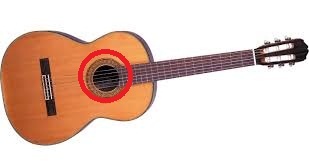Musical Instruments

All stringed musical instruments—like guitar, violin, etc.—have a hollow box behind the strings. (See the sound hole on the hollow box of a guitar, circled red in the picture.)
What purpose does this hollow box serve?
Try my World of Physics to solve many problems like this one.
This section requires Javascript.
You are seeing this because something didn't load right. We suggest you, (a) try
refreshing the page, (b) enabling javascript if it is disabled on your browser and,
finally, (c)
loading the
non-javascript version of this page
. We're sorry about the hassle.
A vibrating sound itself produces a very weak sound which cannot be heard at a distance. Therefore all musical instruments such as guitar and violin are provided with a hollow box (called as sound box ). The box is so constructed that the column of air inside it, has a natural frequency which is same as that of the strings stretched on it. So when the strings are made to vibrate , the air column inside the box is set into forced vibrations, the frequency of which is same as that of the string. Since the sound box has a large area, it sets a large volume of air into vibration, so due to resonance, a loud sound is produced.